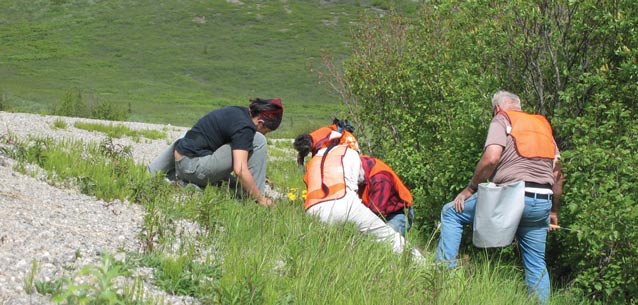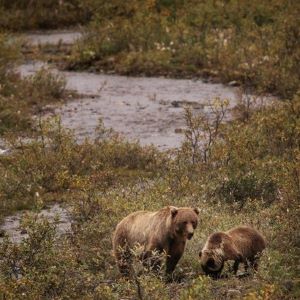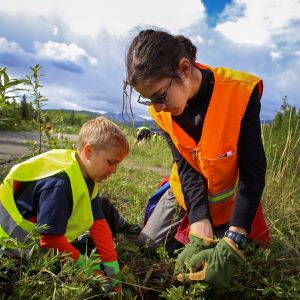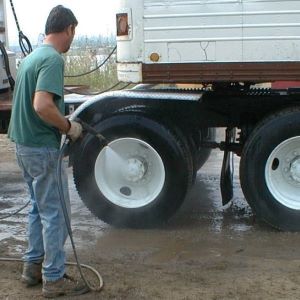
NPS Photo
The weed-digging tool slips into the soil. The orange-vested volunteer wiggles the tool around to make sure that when she plucks up the dandelion, the entire taproot comes with it. Working on the roadside in Denali National Park and Preserve, she adds it to the bag getting heavier with the weight of non-native plants being removed. With limited time, the exotic plant volunteers divide their efforts between pulling dandelions and trying to eradicate or limit the spread of other non-native plants that are more invasive.
Non-Native Plants in Denali
Denali has relatively few non-native plant species (28) compared to native plant species (more than 760). In contrast, many parks and other natural areas in the Lower 48 have hundreds of non-native species (e.g., Yellowstone has more than 200).
The non-native plants in Denali are outside their native geographic range, introduced to a new environment by people. They arrived at the park inadvertently—spreading along the railroad and road corridors, clinging to the mud of cars, buses, and construction equipment, or hidden within gravel or soil deliveries for maintenance projects. Some of these non-native plants are invasive, meaning they grow rapidly and escape beyond where they first arrive. They tend to have robust vegetative growth, abundant seed production, high seed germination, and high longevity of seeds in the soil. Invasive “weeds” often crowd out native species, and may destroy food sources or habitat for native wildlife.
Luckily, most of Denali’s six million acres of wilderness are currently unaffected by non-native plants, because those species are found only in the human-disturbed footprint of the park (entrance area, road corridor, construction sites). Of the non-native species found in Denali as of 2012, some are agricultural weeds which lack the ability to invade native habitats, such as pineappleweed (Matricaria discoidea). Others are successfully being controlled by hand-pulling. Thus, park managers have an opportunity to keep out these unwanted invaders and help keep native ecosystems functioning without adding exotic species to the ecological challenges posed by a changing climate.

NPS Photo
Ecosystem Impacts
Although invasive plants in Denali are largely restricted to areas of human disturbance, this does not mean that they do not affect the health of Denali's flora. Just as most invasives are specially adapted to colonize disturbed areas, quite a few of Denali's native plant species are adapted to live there as well.
For example, think about the many miles of gravel bars built from the constant ebb and flow of Denali's large rivers, and the beautiful flowers and shrub species that grow there on the intermittently disturbed soil. The vegetative communities on these gravel bars support many important plant–animal and animal–animal interactions, as insects pollinate flowers, bears dig for tasty roots, moose and caribou browse willows, and wolves hunt for dinner.
In areas of disturbed soil where invasive plant seed may be present, such as along the park road, native plants may have to compete with the alien invaders to persist. Because most invasive plants are relatively new challengers in the subarctic, the native flora is not necessary adapted to go to war with them.

NPS Photo
Denali’s Exotic Plant Management Team
The National Park Service coordinates 17 Exotic Plant Management Teams (EPMT) rotating among close to 300 national parks. In Denali, the team works exclusively here and consists of the park’s invasive plant coordinator and one or more Student Conservation Association interns. The team frequently recruits volunteer assistance as well.
Each summer, the team tracks the location and extent of infestations of invasive plants that are in or near the park using Global Positioning System (GPS) mapping devices. The team prioritizes its work on invasive plants based on the extent of the invasion (known from the mapping) and the level of threat the invasive species poses to native species (based on an index score previously assigned to each of Alaska's invasive plants). Denali’s EPMT operates using “early detection and rapid response,” meaning that the team will try to eradicate a small patch of an invasive species with a high index score (e.g., bird vetch) before tackling a larger infestation of a less invasive species (e.g., dandelion).
Denali’s EPMT controls investations in the park by hand-pulling the plants or using handheld weed-digging tools, because most invasive plants quickly recover from being cut or mown. While chemical treatments are now allowed within the park, in such a pristine environment, chemicals are only used on a small scale to treat the most invasive plants. Once an invasion is under control, it is sometimes necessary to encourage native plants to regain their hold overly previously infested areas. This is often done by planting native seeds or transplanting vegetation mats.
Volunteers are an integral part of the war on weeds. Over the past 15 years, over 400 volunteers have donated 17,000 hours of their time to remove nearly 10 tons (9,070 kg) of invasive plant material in order to restore Denali to a more pristine state. This is impressive considering that volunteers can only do this work during the short 3-month summer season and that a single invasive plant can weigh as little as 2 ounces, or the weight of an AA battery. This donated time would be equal to one person working 40 hours/week, 12 months a year, for 9 years!

NPS Photo
How You Can Help Denali
The expansion of invasive plants into native habitats can be stopped, but it cannot be done alone. Land managers count on help from many others to protect native ecosystems. Here are ways to assist the EPMT in identifying new invasives and preventing the spread of invasives that have arrived in Denali.
- Before traveling to Denali, wash your vehicle and pay attention to wheelwells, where clumps of mud can be temporary homes for invasive plant seeds.
- Before hiking, examine boots, tents, jackets, and other gear for seeds that might be clinging to fabric or leather. Pick or brush off the seeds and discard them in the garbage.
- Keep an eye out for Denali’s six most invasive plants along the roadside, at bus stops, on the trails, and in the backcountry. Report any suspected new infestations to a ranger by taking photographs and noting the location, so the EPMT can investigate further.
How You Can Help at Home
Denali is not the only place that needs help! Invasive plants are a well-known problem throughout many populated areas. Here are ways to be a part of the solution wherever you live.
-
Take the first step in combatting invasive plants by learning what they are. Learn how to identify the problem species in your area and areas you plan to visit.
- When doing projects around your house, use only certified weed-free straw, mulch, and grass seed mixes. Beware of flower mixes labeled "wildflower"—they may contain seeds of flowers that grow far, far away. Replace any invasive plants you may have growing in your garden with non-invasive alternatives.
- Join organized efforts to remove invasive plants from public lands in your area, or start an effort yourself. Support non-profit organizations that work to combat invasive species and ask your political representatives to support those efforts.
Changing Threats
Although Denali’s subarctic climate may protect it from all but a few of the worst invasive plants, that climate has undergone rapid changes over the past few decades. With scientific predictions indicating more change is on the way, Denali’s pristine wilderness may be at greater risk. Invasive species from warmer climates may make appearances. While the native flora may be challenged by warming climatic conditions, invasives may thrive. Visitors of today will likely see a more pristine plant community in Denali than their children, but with continued diligence in detecting new invasions and persistence in reducing current invasions, we can ensure that native plants will prevail.
Last updated: August 24, 2017
